Displaying items by tag: City One
President Michael D Higgins has been in Limerick this week in honour of its status as Ireland's City of Culture 2014. In addition to other events, a highlight was his award of the Freedom of Limerick, something very special to him as he was born in the Shannonside port.
Ireland's Head of State is keenly aware of the Shannon and Limerick's rich maritime heritage, and he and his party spent almost an hour visiting the "Naumachia in the Cathedral", the exhibition in St Mary's Cathedral of the CityOne sailing dinghies built by trainees with the Ilen Boatbuilding School in the city.
The Ilen Boatbuilding School has several significant cultural aspects, as it was brought into being by Limerick designer Gary MacMahon and Brother Anthony Keane of Glenstal Abbey initially to teach boat-building skills by restoring the 1926-built 56ft ketch Ilen, which was designed by noted Shannon Estuary ocean voyager and adventurer Conor O'Brien.
But then as the work of the school developed, it took on the project of also building 23ft boats of the traditional Shannon gandelow type, specialized craft which evolved over the centuries to deal with the challenges of using the shallow and muddy waters of the Shannon Estuary with its exceptional tidal range.
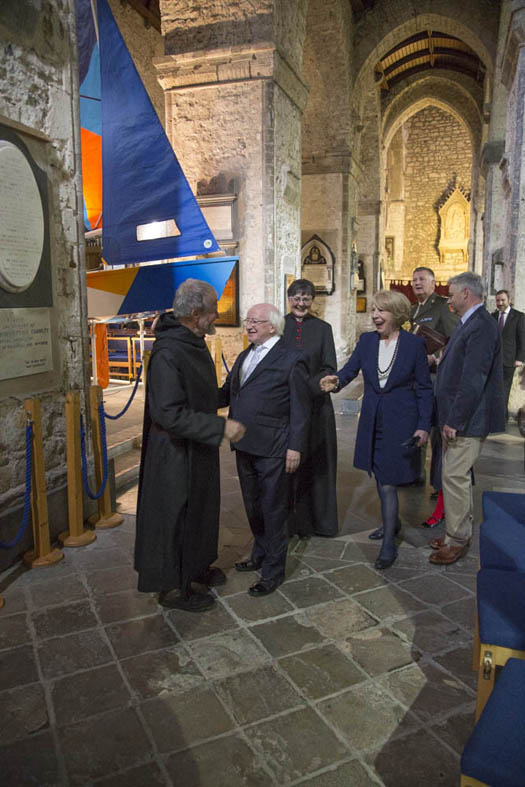
The President of Ireland is welcomed to the Naumachia in the Cathedral by Brother Anthony Keane of Glenstal Abbey. Also foreground are the Dean of Limerick the Very Reverend Sandra Bragnell, Mrs Sabina Higgins, and Gary MacMahon of Ilen Boatbuilding School.
It was the first time any new gandelows had been built in well over thirty years. This project was then further developed to build the CityOne Sailing Dinghies specifically for Limerick use, the unique design of these boats being drawn by naval architect Theo Rye to a detailed Limerick specification. With the new dinghies planned for completion at the height of Limerick's year as City of Culture, a CityOne International Graphic Arts Competition was also launched to create innovative ideas for the colour layouts on the sails and the hulls of the boats. It attracted 61 entries worldwide, and the four selected designs were from graphic artists in Kenya, Ireland Portugal and Texas.

Participants in the Ilen School at the Cathedral included (left to right) Robert Smalle. Tony Broe, Liam O'Donoghue, James Madigan (Ilen School Instructor), Michael Grimes and Gary Wilmott.
It was the CityOne dinghies with their striking colour schemes which formed the centrepiece of the Naumachia in the Cathedral. But there were other exhibits linked to the many aspects of the Ilen School's work too, and in addition to meeting the boatbuilders and crews that sail the CityOnes, the President also met the "Gandelow Gang", who are drawn from the Limerick area both to make up the building teams for gandelows and CityOnes alike, and to row the gandelows in competition and traditional boat gatherings at home and abroad.
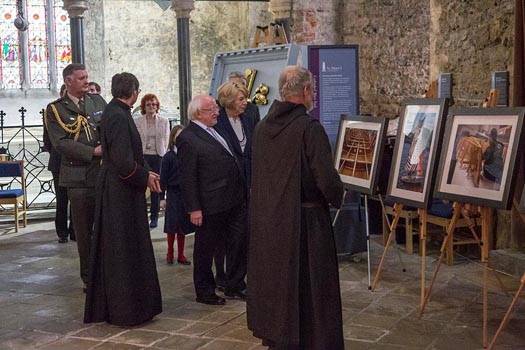
The Presidential party inspect the exhibits detailing the work of the Ilen School
In concluding his speech, the President summed up the mood of the day:
"I very much want to thank everyone involved in staging this exhibition here in this magnificent 12th Century building. What a great tribute it is to those who put all the original stones in place, that there is something new of the human spirit and craft being exhibited here. These boat builders, they are consummate craftsmen.
The international design dimension to the CityOne project is to be highly commended, and it is such a pleasure to be here with you today. I am delighted that the Ilen School project is part of the Limerick City of Culture. Isn't it wonderful that these skills are being passed down and developed, so that more and more people can take part, and for the community to see such inspiring craft?"
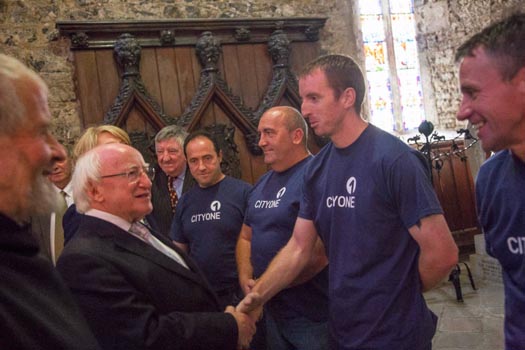
The President meets members of the Gandelow Gang and the Ilen Boatbuilding School including (left to right) James Madigan, Michael Grimes, Gary Wilmott and Tony Broe.
Limerick 'CityOne' Sailing Dinghies Unite The Shannonside Capital As One City
Minister for Finance Michael Noonan, the senior TD in Limerick, yesterday morning launched a "Naumachia in the Cathedral" with the boats built in the visionary CityOne project in the Shannonside city. On Monday afternoon, President Michael D Higgins will also see the boats in St Mary's Cathedral, and meet those involved. It has all become a key part of the Limerick City of Culture 2014, but as W M Nixon reveals, the success of the CityOne dinghies is just part of a remarkable continuing series of creative boatbuilding programmes.
Gary MacMahon of Limerick has a remarkable talent for publicity. Yet he doesn't court it personally. On the contrary, he tends to keep to one side when events he has brought about are in full swing. But because he keeps coming up with visionary ideas which no-one else had thought of before, and also has the ability, patience and quietly persuasive powers to bring them to fruition in the fullness of what is sometimes a very long time, inevitably the novel brilliance of what he has achieved hits the attention button big time.
By profession, he is a graphic and website designer running Copper Reed Studios in Limerick city with his wife Michelle and a staff of six. But like all Limerick people, he has a passion for seeing his home town doing better, improving its image, and making itself a more enjoyable place. And when that passion is allied to the MacMahon powers of vision and dreaming the dream, the results can be extraordinary.
He first came to national attention within Ireland's maritime community back in 1998, when he inspired and organized the return of Conor O'Brien's ketch Ilen from the Falkland Islands. In 1923-25, the magnificent voyage by Conor O'Brien of Foynes on the Shannon Estuary round the world in the 42ft ketch Saoirse – which he'd designed himself to be built in Baltimore – had in turn resulted the Falkland Islanders being so impressed by Saoirse when she sailed in to their lonely archipelago after rounding Cape Horn, that they ordered a larger sister sister-ship to be built for their inter-island service vessel.
This resulted in the cargo and passenger carrying 56ft ketch Ilen, designed by O'Brien (an architect by training though a writer by vocation)) and Tom Moynihan, who'd built Saoirse and now built the new vessel in Baltimore in 1926. The ketch finished, the difficulty was getting her to her new owners in the Falklands. In the end, to get insurance for the delivery trip in which he would be in command, O'Brien had to register the Ilen as a yacht, and he sailed her out to the Falklands as he'd sailed Saoirse, under the burgee of the Royal Irish Yacht Club, with Ilen crewed by two islanders from Cape Clear.
Meanwhile Saoirse, having gone through a few mostly happy ownerships, was wrecked after being driven from her moorings in a hurricane in Jamaica in 1979. The gallant Ilen, still working away in the Falklands and now fitted with a larger auxiliary engine, continued to give good service. But by the 1990s the word was that she was no longer in use, having been laid up on moorings at Port Stanley, reportedly in basically quite good order but inevitably suffering from the region's severe weather.
Ilen was now unique as the only surviving O'Brien seagoing design. So one crisp morning in the winter of 1997-98, Gary MacMahon suddenly found himself possessed by the notion that the Ilen should be brought back to Limerick just as soon as possible to act as a re-birth symbol for the revitalization of a riverine city and its mighty Shannon Estuary, all of which were going through turmoil with industrial decline and the moving of Limerick port's operations downstream to Foynes and other deep-water pier locations.

The Conor O'Brien-designed, Baltimore-built 56ft ketch Ilen back in Irish waters in 1998 for the first time since 1927. She is seen here in Dublin Bay before being sailed to Oldcourt on the Ilen River in West Cork. Photo: W M Nixon
Quite how he managed it all we can only guess, but within what seemed like a matter of days he found himself in Port Stanley with the deal done to buy the Ilen, and in the early Spring of 1998 she was unloaded from a ship in Dublin docks. Now what? Clearly, the old ketch needed massive restoration work in order to make her fit for any regular seagoing service under sail with trainees or passengers on board. But with her size and the special demands of her age and construction, there was only one place in Ireland where the work could be confidently undertaken, the Hegarty boatyard at Oldcourt on the River Ilen in West Cork just a few miles upstream from Baltimore where the ketch had been built 72 years earlier.
So in the summer of 1998 she was commissioned in Dublin Bay, and sailed under the command of Paddy Barry to Baltimore and a rapturous welcome. Then in time she was hauled into and old stone waterfront shed in Oldcourt, and here she has been ever since while a continuing programme of restoration has become, as is so often the case with old well-used boats, a virtual re-build, but done in such a way that the shape of the original vessel is exactly replicated, and at any time in going into the shed you are in fact looking at the Ilen.
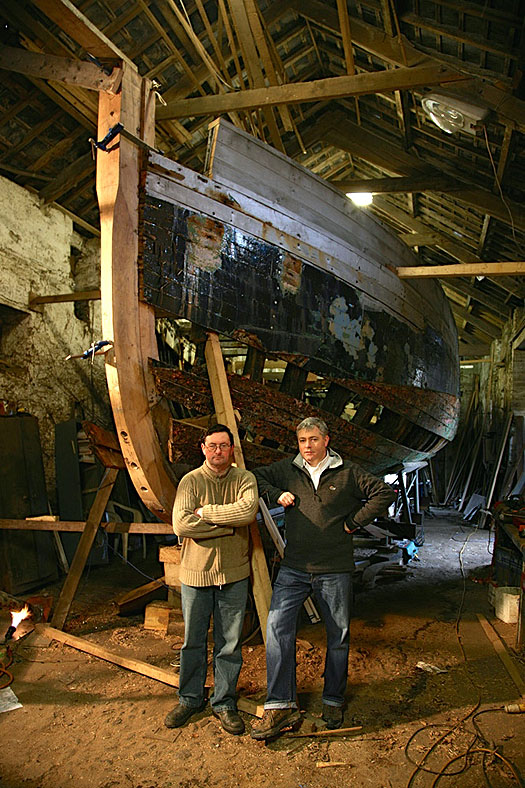
Work in progress – and it's still in progress. Boatbuilder Liam Hegarty (left) and Gary MacMahon at an early stage of the Ilen restoration, when the stem had been replaced.

Replacing frames in Ilen at Oldcourt. Once the frames are all located, planks can also be replaced where necessary without any loss of the vessel's shape.
To do this, trainee boat-building schemes were implemented, with a strong Limerick emphasis in the recruiting. It soon acquired an international element with an input from many renowned traditional boatbuilders, until five years ago it was given a more formal structure with the establishment of the AK Ilen Boatbuilding School. The work continued in Oldcourt, but they also had bright new premises in Limerick where deckhouses and so forth for the Ilen could be built. But it was very quickly realized that a building programme for smaller boats in the Limerick premises would also provide a rewarding interest for people from all sorts of backgrounds who could find fulfillment – often unexpected fulfillment and mental serenity – in working with wood and building boats.
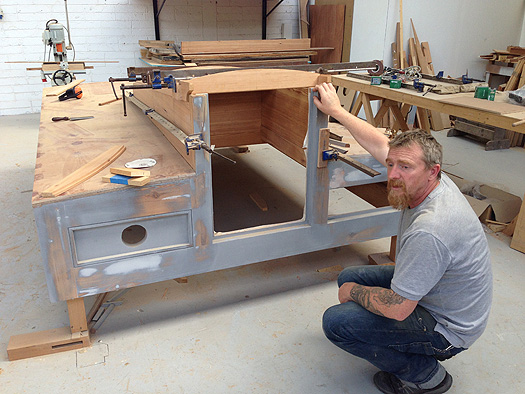
Ship's carpenter JimMcInerney with the new deckhouse for Ilen in the boat-building school's Limerick premises
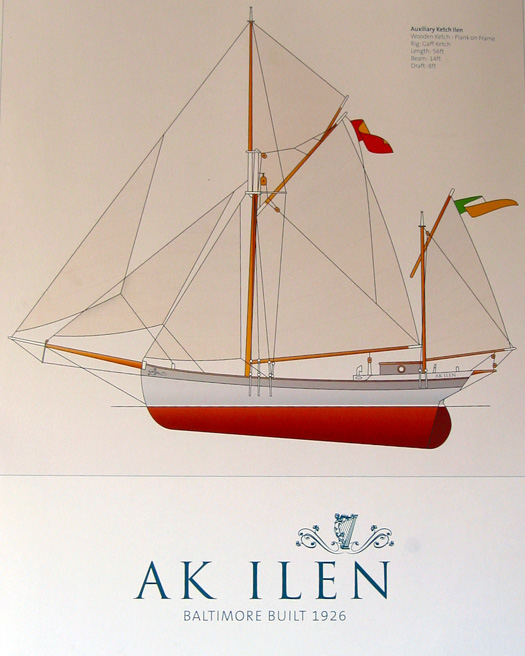
The objective – Ilen as she will look when restored. Her underwater profile was shaped to facilitate landing people and goods at drying quays, or even directly onto a beach.
Initially they used a simple dory design, but then came a typical MacMahon stroke of genius. There's a type of boat unique to the Shannon Estuary known as the gandelow. The classic gandelow is around 23ft long, and while above the water she may look like a hefty version of a typical Irish clinker-built lakeboat as beloved by the mayfly fishermen, underneath she is completely flat-bottomed in order to have minimum draft, and to be capable of slithering across the gooey mud with which the 60-mile long Shannon Estuary, with its 5 metre tidal range, is generously provided.

New gandelows a-building. The project eventually fused into the programme for Limerick City of Culture 2014
Quite how the name "gandelow" emerged back in the mists of time from a mangling of the Venetian word "gondola", if indeed it did, is anyone's guess. But the old boats are still actively used – a good place to see them is just below the bridge at Bunratty. However, with the encroachment of glassfibre workboats and robust aluminium knockabouts, it was at least thirty years since a new gandelow had been built in traditional style. But when Gary MacMahon and his team had their lightbulb moment to build a flotilla of 23ft gandelows in the Ilen base in Limerick, everything began to come much more strongly to life, and the Gandelow Gang was born.
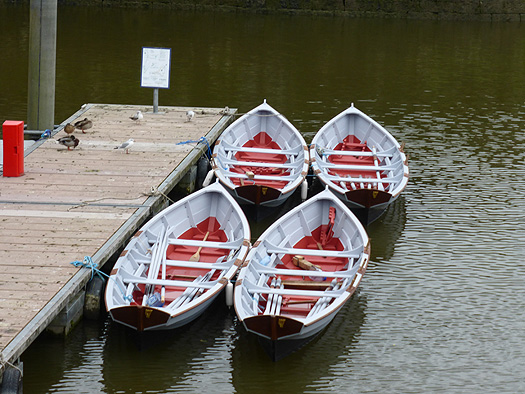
The elegant drawn-out transom of a gandelow.......Photo: W M Nixon
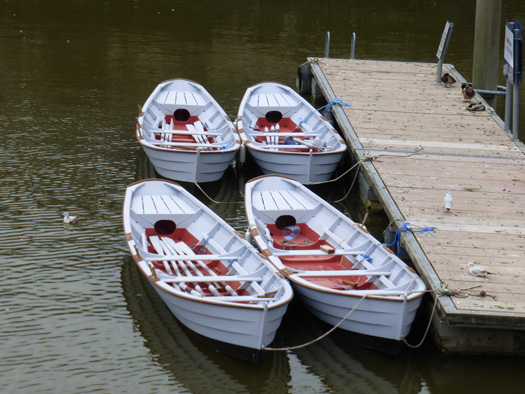
...contrasts markedly with the no-nonsense shape of the bow. Photo: W M Nixon
The real secret of the success of such a project is that once the boats are built, they must as more than interesting maritime objects. They have to be used, and used as much as possible, taken to different venues and rowed in active competition both for team building and the sheer sport of it all. The classic gandelow is rewarding to row. She's hefty enough, but with proper teamwork quite a respectable speed is possible, and the sport is good but as with any boat racing, skilled mark-rounding can be crucial to success, particularly so with these flat bottomed skid-pans which can slide sideways when you're trying to cut through on the inside curve.
As for locations, in 2014 alone the Gandelow Gang have been making the scene at the Battle of Clontarf re-enactment in April (after all, the original winner Brian Boru was a Limerick man, even if he was killed at the end of it). Then in late April they were in Venice. Just like that. For where else in Europe would you feel obliged to take a gandelow?

Getting afloat in Venice, Limerick style. The Gandelow gang had to make their own launching arrangements when they arrived in the Serenissima.....
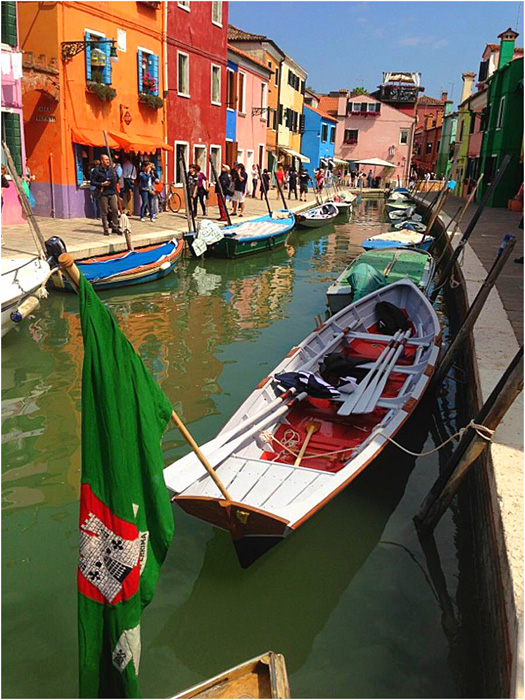
.....but once established in Venice, they were soon part of the scene
When Limerick folk decide to up and go from their homely city, they get on and do it, and though they were co-ordinating with the Serenissima's Master of Waterborne Ceremonies in Venice, they did many things their own no-nonsense way. And as for how a squad of ordinary Limerick people can afford a six-day stay in one of the most expensive cities in the world, the word is they sussed out a convent right at the heart of things where deserving guests can stay for €25 per night.

The Baltimore Wooden Boat Festival in May provided another showcase for the gandelows. Seen here rowing their classic Limerick boat towards the gaff ketch Sile a Do are Liam O'Donoghue, Anthony Kenny and Robert Smalle
For the gandelows back from Venice, in addition to races at home, 2014 continued with the Baltimore Wooden Boat festival at the end of May, the Lough Scur Midsummer Festival in June, and the Ballydehob Gathering of the Boats in August (see this blog September 6th). This would be enough for most of us to be getting along with, but back in the Ilen base in Limerick another project was rapidly taking shape, the CityOne sailing dinghies.
Inner city interest in small boats in Limerick had been aroused by the gandelows, so the building of a class of sailing dinghies was seen as adding a logical new element. But while some people thought something like a GP 14 or the heftier Wayfarer might best fill the bill, this was to miss the point of the Ilen experience entirely. To work, the boats had to be built in Limerick in the first place, and be to a unique design.
If this sounds a bit crazy, look at it as the small boat version of craft beers. Just about every town and village in Ireland now has its own craft brewery, and they cater for a thriving home and export trade for public tastes jaded by standardization and centralization. The making of the beers is as much part of the interest as their tasting and consumption. Equally so is the Ilen School philosophy for boats. The new CityOne dinghies were to be built from scratch, and their team-led construction, by people from every walk of life who had found a worthwhile interest in building small boats, would be vital to the success of the project.

Gary MacMahon (left) with Theo Rye, designer of the CityOne. Photo: W M Nixon
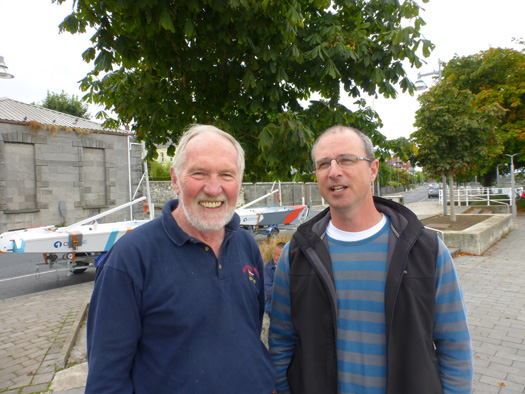
Hal Sisk (left) assembled a team to publish the G L Watson book, and from that Theo Rye (right) became the designer of the CityOne. Photo: W M Nixon
Everything hung on finding the right design. But with typical MacMahon serendipity, the right man was brought in. Gary had been much involved in his work as a designer with Hals Sisk's Peggy Bawn Press in creating that masterful and massive volume, the copiously-illustrated "G L Watson, the Art & Science of Yacht Design" by Martin Black, a wonderful account of the story of the great Scottish yacht designer which has deservedly won international awards since its publication in 2011. And among the team of all the talents involved in its creation was naval architecture historian and innovative boat designer Theo Rye, who was soon absorbed by the challenge of creating a design for a sailing dinghy which would be rewarding to sail, yet could be built in Limerick in timber – mostly plywood – by enthusiasts many of whom had little or no skill in boatbuilding, or even elementary woodwork.
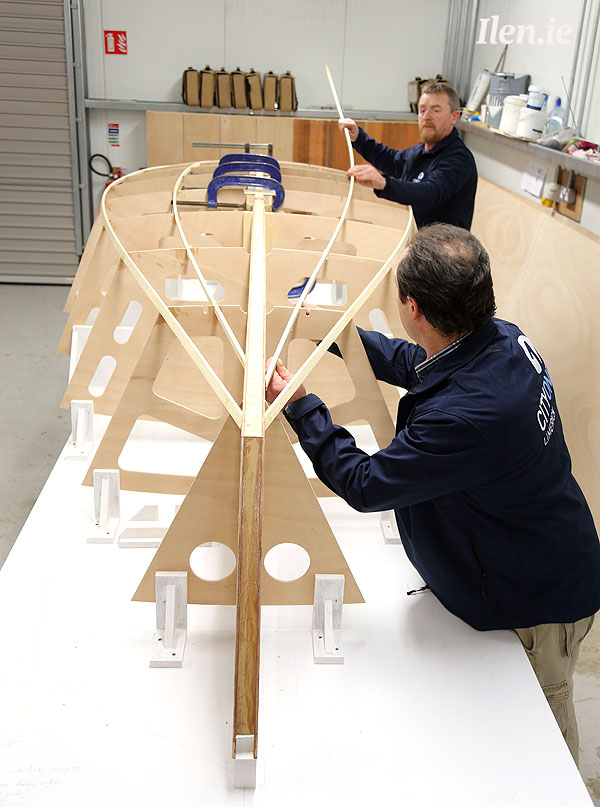
Early building stage of the first CityOne
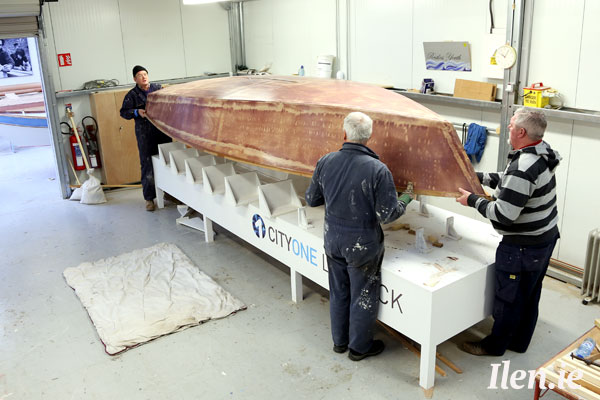
The basic hull is lifted clear........

....and the attractive wood engineering of the interior is completed.
The result is a basically simple flat-bottomed design but with some beautiful wood engineering, as you'd expect with Hal Sisk donning his other hat as an engineer to make input into the construction details. Yet overall the concept is one of attractive simplicity. To move on from this, the Ilen group organized an international graphic design competition for ideas for the colour schemes for the first four boats. They attracted 61 entries worldwide, and the four selected schemes were from Cale Funderburk of Texas, Andre Aguiar of Portugal, Kashyap Gohel of Kenya, and Con Ryan of Limerick.
We've had teaser photos on Afloat.ie in recent weeks showing the first of these hyper-colourful boats having their trial sails, but believe me folks, you ain't seen nothing until you've seen them all together, and that only became possible last Saturday morning as the last of the foursome had only had her final coat of paint on Friday night.
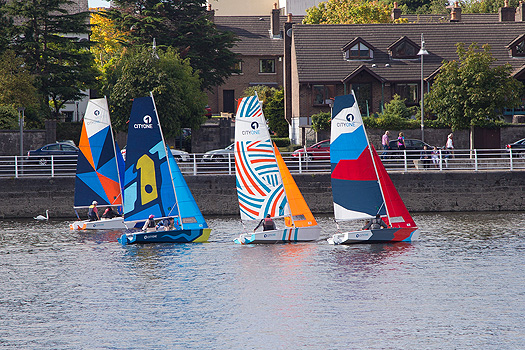
The first four CityOne dinghies racing together on the Shannon in the heart of Limerick on Saturday September 20th 2014 are decorated in the colour schemes created by (left to right) Con Ryan (Ireland), Kashyap Gohel (Kenya), Andre Aguiar (Portugal) and Cale Funderburk (Texas).
It was just in time, and what a time we had down on Shannonside in Limerick last Saturday, with the CityOne flotilla making their debut in the heart of town in a series of races masterminded by Geoff O'Donoghue of Lough Derg YC, while the gandelows staged a regatta in tandem with the sailing with some mighty oarsmanship.
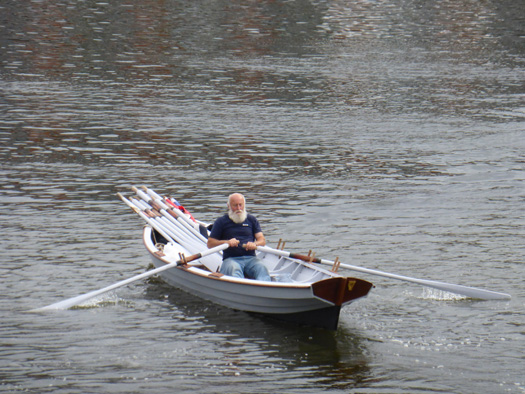
Off to the races. Gandelow stalwart Liam O'Donoghue rows across the river with oars and pennants ready to race. Photo: W M Nixon

Geoff O'Donoghue of Lough Derg YC calls the first start of the gandelow races, which got off to a slightly ragged beginning.......Photo: W M Nixon
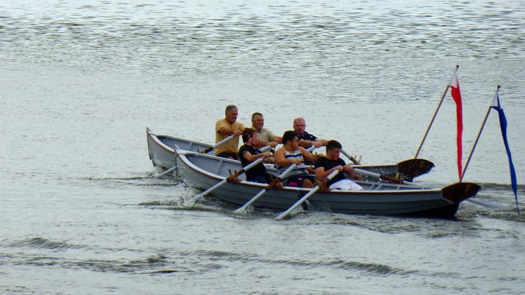
......but soon the crews were settling into their stride......Photo: W M Nixon

.......and by the finishes, the winning crews were setting a ferocious pace. Photo: W M Nixon
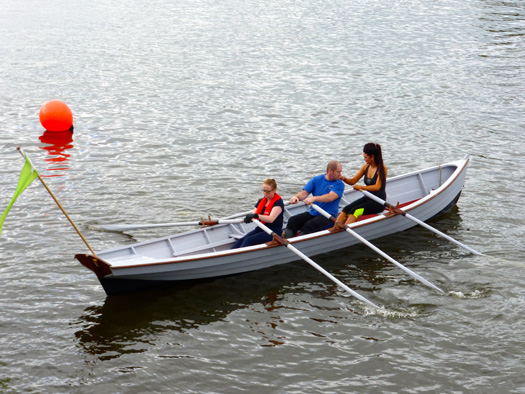
The Ladies Crews were allowed one man on board....Photo: W M Nixon

....but when it came to the racing, they were equally determined. Photo: W M Nixon
The sailing and rowing images which have resulted project a Limerick many people won't recognize from popular perceptions of that once-gritty town, but Limerick in its year as City of Culture is being re-born at astonishing speed. Thus the comfortable suburbs along the west side of the river provided an affluent, well-established and leafy background, but across on the east side, right in the heart of the old city's waterfront, the re-born Howley's Quay, with rugby legend Peter "The Claw" Clohessy's pub at the centre of it, provided an ideal regatta headquarters.
Pride of place in the Clohessy super-pub establishment is a completely re-vamped fine dining venue. As Gary MacMahon happened to be the design consultant on that, he persuaded the boss that it should be re-named The Gandelow Restaurant. So with the gandelows effecting their crew changes at the steps inside the new boardway right at the pub, all our ducks – and swans too – were neatly in a row to get a photo of a gandelow at The Gandelow.
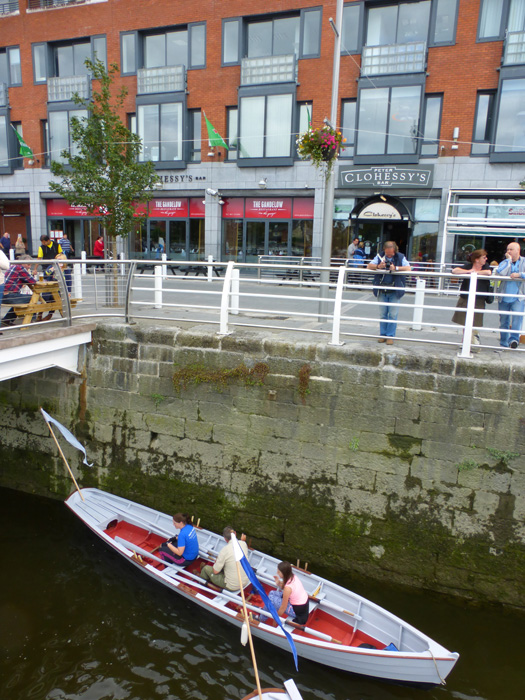
Peter Clohessy's famous bar-restaurant on Howley's Quay in Limerick provided an ideal regatta base......Photo: W M Nixon
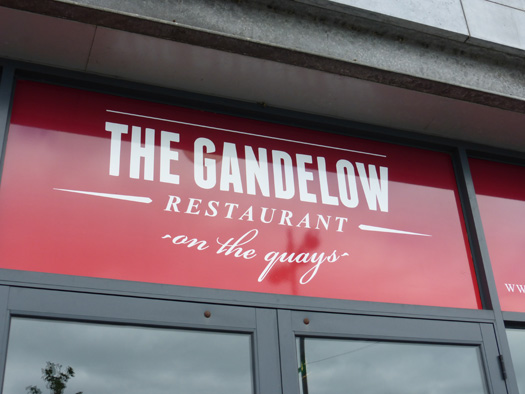
....and he in turn has re-named his fine dining venue in honour of the local traditional boats. Photo: W M Nixon
As to the CityOne racing, it was basically between teams from Culaun SC in Clare, Lough Derg YC, NUI Galway SC, two teams from Garrykennedy SC, Foynes YC, Killaloe SC, and the "Constructors Sailing Club" team which included Gary MacMahon, Theo Rye, Hal Sisk, and Steve Morris the talented New Zealand shipwright who led the building of the superb Sally O'Keeffe down in Kilrush (see this blog on May 10th), and whose guidance in the CityOne project was invaluable.
Many others were involved as RIBS were on hand to bring about crew changes and get as many people as possible, experienced and newcomers alike, out sailing in these remarkable little boats. But in the end, after working out a formula which only he fully understood, Geoff O'Donoghue declared that the winners were NUI Galway led by Cian Walsh.
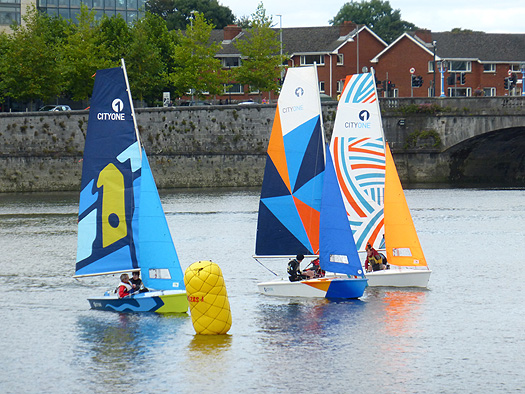
A dream comes true. New boats of the CityOne class sailing together in the heart of Limerick. Photo:W M Nixon

The Shannon in Limerick becomes busy towards high water. Two new boats of the CityOne class are in pre-start manouevres while crews are conveyed to other boats by RIB, and at the west bank a four-oared racing shell from St Michael's Rowing Club finds a clear passage upriver. Photo: W M Nixon
However, the complexity of the racing formula tested even the commentary skills of another of the Ilen team, Brother Anthony from Glenstal Abbey. But his real strength being words which emerge from a quiet study, his thoughts came clearly forefront yesterday, as it was he who thought of calling the current display of the CityOne boats in St Mary's the "Naumachia in the Cathedral".
In this blog in times past, we've outlined the difficulties of making sailing a spectator sport by referring to the experiences of Roman Emperors who occasionally flooded the Colosseum to stage naval battle re-enactments, but even they found these bloodthirsty shows prohibitively expensive. However, thanks to Brother Anthony's research we find that the ancient Greeks were there first, as they coined the phrase Naumachia to capture the flavour of an enclosed naval engagement in a stadium setting. Now, down in Limerick, they've revived it, but with entirely peaceful connotations for boats on harmonious display in a cathedral.
That said, there was once something of a battle in St Mary's Cathedral, and it brings our story full circle by noting that it involved Conor O'Brien of Saoirse fame. Though he didn't practice very much as an architect, one job he took on shortly before leaving on the great voyage of the Saoirse was the design of a screen for St Mary's commissioned by the Glentworth family.
It had been mostly completed in the workshop before he departed in June 1923, but it wasn't installed until he was thousands of miles away in the midst of his voyage. They managed to put it in back-to-front. And it was only O'Brien himself who noticed his on his return. He was a man with a notoriously short fuse. It boggles the mind to imagine the scene.
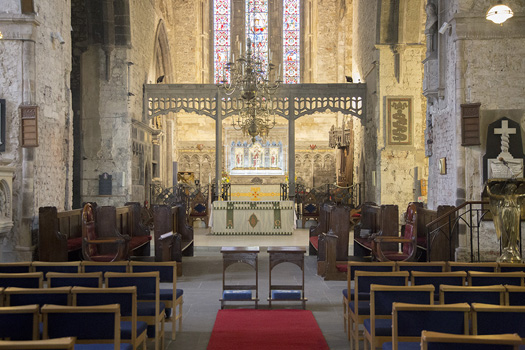
The Glentworth Screen in St Mary's Cathedral in Limerick was originally installed back-to-front while its architect Conor O'Brien was away on his famous voyage around the world in Saoirse..
But now, with the Glentworth Screen the right way round, all is sweetness and light in St Mary's Cathedral for the boats of the Ilen school. Michael Noonan TD launched the exhibition yesterday. President Michael D Higgins will be there on Monday afternoon. And as the boats are in the Cathedral for another two weeks , it's well worth seeing for a project which has helped to give unexpected added meaning to Limerick's role as City of Culture.
For as Minister Noonan put it at his launching of the exhibition: "I have always had the notion that the divisions between art and craft were too separate in Ireland, and that not enough credit was given to people that can do things with their hands, and are truly expert in their craft. There is a much wider concept where the artists and craftsmen come together and you get an integrated culture, and we can all celebrate that coming together here today".

Sea and city intertwine. The new boardwalk bridge at the Howley's Quay Steps was ideal as a viewing platform, while the steps greatly aided crew changes for the gandelows. Photo: W M Nixon
Limerick's Boat Building Tradition Enters New Phase With 'City One' Dinghy Launch
#cityone – Limerick's long tradition of boat building has entered a new phase with the innovative 'City One' design from the Ilen school and network for wooden boat building taking to the water this weekend writes Andrew Carey.
The school, which has built the traditional Gandelows, took inspiration from the traditional Shannon river boat to design the new 'City One' and have it ready for the annual festival of racing on the river.
"The City One is designed for the River Shannon and the city. Limerick has the biggest number of tides in the country and the river demands a dynamic boat and these boats have been designed with that in mind," explained project co-ordinator, Gary Mc Mahon.
Gandelow Races start at 1.30pm this Saturday from Howley's Quay, Limerick City Centre and the organisers are hoping for a fine day for the spectators but a good wind to show the boats at their best.
This year's Gandelow Races include the special 'City One' Limerick sailing challenge, which involves the launch and racing of four of the new and spectacular performance sailing boats, designed for racing between the bridges of Limerick and custom-built at the Ilen School in Roxboro, a Limerick City of Culture #madeinlimerick legacy project.
"In essence, spectators can expect to see dynamic and highly competitive river rowing and sailing - rowing, in the racing of Limerick's unique and elegant traditional fishing-boat," said Gary.
The races this year have entries from familiar and popular teams, coming from the city and beyond - with competition is heating up between the Limerick City and County Clare teams.
The 'City One' races will be held in association with Lough Derg Yacht Club and will have experienced teams competing in an exciting and challenge race format.
The new boats will also be on view on Culture Night (this Friday) at Howleys Quay and there will be yet another opportunity to see them at an exhibition to be launched on September 26 in St Mary's Cathedral, as the 'City One' sail boat decoration was the subject of an international graphic design competition.
Ilen Project 'CityOne' Dinghies for Culture Night, Limerick City
#cityone – The Ilen School's new sailing boat CityOne will be on exhibition for Culture Night in Limerick City, Friday September 19th. A fleet of four CityOnes will be on view from 6pm to 9pm on Howley's Quay.
Culture Night, an annual all-island public event which celebrates culture, creativity and the arts, is a wonderful platform from which to exhibit the boats, whose dynamic graphics are the four selected designs from a very sucessful CityOne International Graphic Arts Competition. The boats have recently been designed and built in the Ilen School, Limerick City, as part of City of Culture celebrations.
The CityOnes will race the following day, September 20th from 1.30pm Saturday at Howleys Quay, Limerick City.
New Irish Sailing Dinghy Design 'The City One' Launched in Limerick
#cityone – This year's Gandelow Races to be held at Howley's Quay, in Limerick City Centre at 1.30pm Saturday 20th September includes a special event: The CityOne Limerick Sailing Challenge, which involves the launch and racing of the new, spectacular performance sailing boats designed for racing between the bridges of Limerick. As Afloat previously reported the design of the boat is from the drawing board of Theo Rye.
The event is also attracting big interest from Gandelow teams in Limerick City and County and County Clare.
The first race starts at 1.30pm at Howley's Quay, Limerick.
#cityone – The Ilen School CityOne Design Competition invites designers to submit designs for the sails and hull of a new CityOne performance sailing dinghy. Four of these CityOne dinghies are currently under construction through an innovative social educational programme in Limerick City.
As Afloat reported previously, The CityOne dinghy is a new performance dinghy, developed by the Ilen School and designed by naval architect Theo Rye as a legacy project of Limerick City of Culture 2014.
This exciting and challenging competition is open to all designers and high levels of creative freedom are encouraged for the task of designing a concept for application to the hull and sails.
Submissions must be sent by email to [email protected] There is no entry fee.
Three designs will be chosen by a judging panel and each single participant and group design chosen will receive €500* and enjoy the opportunity of seeing their designs creatively applied to the City One sail and hull before they take to the water for racing on the River Shannon, Limerick. The judging panel may also award additional non-monetary, special mentions.
Closing date for submissions Friday 25th July 2014. More on this on the City One competition page here.
#cityone – An international and local team of boat builders and naval architects have assembled at the Ilen School, Roxboro, as part of the Limerick City of Culture 2014 celebrations. The school is well underway towards the rollout of its Limerick City of Culture Sport and Legacy Project, which involves, as Afloat reported earlier the design and build of a new innovative sailing dinghy for Limerick City and a fleet of new 23′ rowing Gandelows.
The school, which is devoted to excellence in teaching and learning through the medium of boat building and related crafts, offers to the local and wider community, direct involvement in boat building, rowing, sailing or visits to the school workshop, to see at first hand the ongoing work.
New 'City One' Sailing Dinghy Design Built for Limerick's River Shannon
#cityone – A new Irish sailing dinghy design, the LC1, is under construction in Limerick which promoters say will have a 'lively performance but at the same time, the relatively broad beam and inherent stability should mean it is not difficult for the inexperienced.
The City One Limerick Dinghy from the AK. Ilen Company is designed for use on the Shannon as it passes through the city and opens into estuary on its way to the Atlantic. The LC1's launch will tie in with celebrations of Limerick's 2014 City of Culture celebrtations.
The design of the boat is from the drawing board of Theo Rye.
The keel of the LC1 is laid and according to the latest progress reports the keel of the prototype is laid, and within the next few weeks, some of the world's 'finest craftsmen' from New Zealand, North America and elsewhere will be in the Ilen Boat Building School working in conjunction with Limerick's boatmen on the project.
The design marries traditional and modern design elements. Most modern dinghies are factory made in fiberglass or plastic. The LC1's hull is specifically for relatively simple construction in timber and plywood with a hard chine and constant radius underside.
Many thousands of dinghies of this type were built in the 1950s and 60s, often by amateurs at home. The relative simplicity of the design means no especially difficult boatbuilding skills will be necessary, so the satisfaction of construction is brought into the reach of nearly anyone with enthusiasm and time. The pride of achievement in helping build a boat and then sailing it will excite and interest children and adults, and there are numerous benefits and educational opportunities associated with this process. The materials specified are reasonably cheap and easy to source.
The use of epoxy to coat the timber and fillet the ply together, and the painted finish, will help reduce the maintenance and upkeep often associated with wooden boats, and any repairs necessary should be simple to do as well. The design is also intended to quickly self-drain after righting from a capsize, a feature of many modern designs; "coming up dry" has the benefit of allowing the boats to be left safely on moorings afloat without covers if necessary.
The raked stem reflects that this design is not driven by a rating rule;the stem allows the bow to retain buoyancy when driven hard, and it often means a less abrupt stop in the event of a collision, too. That points to the intention that the boat should be user friendly both for novices as well as more experienced sailors.
In the right hands, the design should enable lively performance and keen racing; but at the same time, the relatively broad beam and
inherent stability should mean it is not difficult or intimidating for the inexperienced or less confident.
The hull shape is intended to be tolerant of crew weight, and allow crews of two, three or even four people, making it a design suitable for teaching sailing with an instructor on board. The high boom and "gnav" mean there is less likelihood of knocking heads with the boom or kicking-strap, and the clear Mylar sails enable good visibility.
The size of the jib is such that even relatively small crew members should find it easy to trim, and without a trapeze no special athleticism is required. The simple layout and lack of complexity in the rig should also mean rigging is quick and easy, helping get people onto the water rapidly and easily.
The Shannon river has always been central to the history and life of Limerick, and sailing right in the center of the city should reawaken an awareness of its fundamental marine and riverine dimension and perspective.
The unique topography of the area brings its own challenges: balancing the need for a relatively generous sail plan to keep the boat moving in the lee of the city buildings with the requirement for a user-friendly and safe boat to sail in relatively confined waters.
The confines of the river mean short legs and lots of manoeuvres, so the hull is rockered to enable quick tacks; there is no spinnaker. The design is also intended for safety in less sheltered waters like the lower Shannon estuary. The relatively high freeboard and built in buoyancy should make it safe under reasonable conditions on any stretch of water from sea to lake to river.
More on this from the AK. Ilen Company here: www.ilen.ie





































































